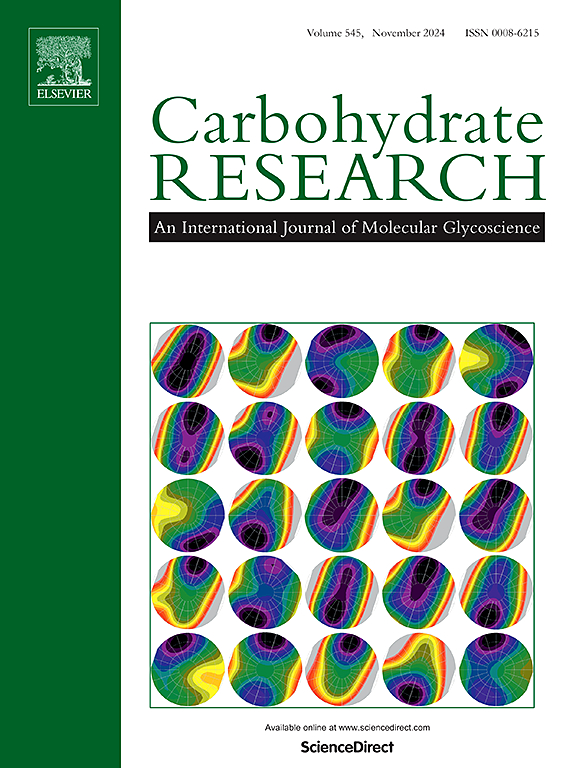Structure of the K58 capsular polysaccharide produced by Acinetobacter baumannii isolate MRSN 31468 includes Pse5Ac7Ac that is 4-O-acetylated by a phage-encoded acetyltransferase
IF 2.4
3区 化学
Q3 BIOCHEMISTRY & MOLECULAR BIOLOGY
引用次数: 0
Abstract
Capsular polysaccharide (CPS), a heteropolymeric carbohydrate structure present on the cell surface of most isolates of the bacterial pathogen Acinetobacter baumannii, is a major virulence determinant. Here, the CPS produced by A. baumannii MRSN 31468, which carries the KL58 CPS biosynthesis locus, was studied by sugar analysis, one- and two-dimensional 1H and 13C NMR spectroscopy. The structure was found to consist of a repeating tetrasaccharide K-unit that includes glucose (d-Glcp), galactose (d-Galp), N-acetyl-galactosamine (d-GalpNAc), and 5,7-diacetamido-3,5,7,9-tetradeoxy-l-glycero-l-manno-non-2-ulosonic acid (5,7-di-N-acetylpseudaminic acid; Pse5Ac7Ac). The CPS has a branched repeating unit with the disaccharide →3)-β-d-Glc-(1→3)-β-d-GalNAc-(1→ as the mainchain and O-6 of the Glc unit substituted with the disaccharide β-Pse5Ac7Ac-(2→6)-α-d-Gal, and Pse5Ac7Ac is partially acetylated at O-4. The presence of Pse5Ac7Ac in the K58 structure is consistent with the presence of psaA-F genes in KL58, which are responsible for Pse5Ac7Ac synthesis. 4-O-acetylation of Pse5Ac7Ac was traced to an acetyltransferase, Atr44, which was found to be closely related to Atr29 that similarly decorates Pse5Ac7Ac with 4OAc in the K46-type CPS. Atr44 like Atr29 is encoded by a gene found in a prophage. The K58 CPS produced by MRSN 31468 did not include the 8-epimer of Pse5Ac7Ac (5,7-di-N-acetyl-8-epipseudaminic acid; 8ePse5Ac7Ac) found in the closely related CPS from BAL062 that also carries KL58. Hence, the gene(s) for conversion of Pse5Ac7Ac to 8ePse5Ac7Ac must lie elsewhere.

鲍曼不动杆菌 MRSN 31468 分离物产生的 K58 胶囊多糖的结构包括由噬菌体编码的乙酰转移酶进行 4-O 乙酰化的 Pse5Ac7Ac。
胶囊多糖(CPS)是一种存在于大多数细菌病原体鲍曼不动杆菌分离物细胞表面的杂聚碳水化合物结构,是一种主要的毒力决定因素。本文通过糖分析、一维和二维 1H 和 13C NMR 光谱对携带 KL58 CPS 生物合成基因座的鲍曼不动杆菌 MRSN 31468 产生的 CPS 进行了研究。研究发现,其结构由重复的四糖 K 单元组成,包括葡萄糖(d-Glcp)、半乳糖(d-Galp)、N-乙酰半乳糖胺(d-GalpNAc)和 5,7-二乙酰氨基-3,5,7,9-四去氧-l-甘油-l-甘露-2-酮-2-磺酸(5,7-二-N-乙酰假氨基酸;Pse5Ac7Ac)。这种 CPS 具有一个支链重复单元,以二糖 →3)-β-d-Glc-(1→3)-β-d-GalNAc-(1→为主链,Glc 单元的 O-6 被二糖 β-Pse5Ac7Ac-(2→6)-α-d-Gal 取代,Pse5Ac7Ac 的 O-4 部分被乙酰化。K58 结构中 Pse5Ac7Ac 的存在与 KL58 中负责合成 Pse5Ac7Ac 的 psaA-F 基因一致。Pse5Ac7Ac 的 4-O 乙酰化可追溯到乙酰转移酶 Atr44,发现它与 Atr29 关系密切,后者在 K46 型 CPS 中同样用 4OAc 修饰 Pse5Ac7Ac。与 Atr29 一样,Atr44 也是由噬菌体中的一个基因编码的。MRSN 31468 产生的 K58 CPS 不包括 Pse5Ac7Ac 的 8-表聚体(5,7-di-N-乙酰基-8-表假氨酸;8ePse5Ac7Ac),这种 8-表聚体存在于同样携带 KL58 的 BAL062 的近亲 CPS 中。因此,将 Pse5Ac7Ac 转化为 8ePse5Ac7Ac 的基因肯定不在这里。
本文章由计算机程序翻译,如有差异,请以英文原文为准。
求助全文
约1分钟内获得全文
求助全文
来源期刊

Carbohydrate Research
化学-生化与分子生物学
CiteScore
5.00
自引率
3.20%
发文量
183
审稿时长
3.6 weeks
期刊介绍:
Carbohydrate Research publishes reports of original research in the following areas of carbohydrate science: action of enzymes, analytical chemistry, biochemistry (biosynthesis, degradation, structural and functional biochemistry, conformation, molecular recognition, enzyme mechanisms, carbohydrate-processing enzymes, including glycosidases and glycosyltransferases), chemical synthesis, isolation of natural products, physicochemical studies, reactions and their mechanisms, the study of structures and stereochemistry, and technological aspects.
Papers on polysaccharides should have a "molecular" component; that is a paper on new or modified polysaccharides should include structural information and characterization in addition to the usual studies of rheological properties and the like. A paper on a new, naturally occurring polysaccharide should include structural information, defining monosaccharide components and linkage sequence.
Papers devoted wholly or partly to X-ray crystallographic studies, or to computational aspects (molecular mechanics or molecular orbital calculations, simulations via molecular dynamics), will be considered if they meet certain criteria. For computational papers the requirements are that the methods used be specified in sufficient detail to permit replication of the results, and that the conclusions be shown to have relevance to experimental observations - the authors'' own data or data from the literature. Specific directions for the presentation of X-ray data are given below under Results and "discussion".
 求助内容:
求助内容: 应助结果提醒方式:
应助结果提醒方式:


